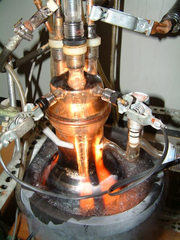
Atomic carbon
Encyclopedia

Chemistry
Chemistry is the science of matter, especially its chemical reactions, but also its composition, structure and properties. Chemistry is concerned with atoms and their interactions with other atoms, and particularly with the properties of chemical bonds....
is single carbon atom
Atom
The atom is a basic unit of matter that consists of a dense central nucleus surrounded by a cloud of negatively charged electrons. The atomic nucleus contains a mix of positively charged protons and electrically neutral neutrons...
with chemical formula :C: - in effect a dicarbene
Carbene
In chemistry, a carbene is a molecule containing a neutral carbon atom with a valence of two and two unshared valence electrons. The general formula is RR'C:, but the carbon can instead be double-bonded to one group. The term "carbene" may also merely refer to the compound H2C:, also called...
.
This very short lived species is created by passing a large current through two adjacent carbon rods, generating an electric arc. Atomic carbon is generated in the process. Professor Phil Shevlin
Phil Shevlin
Professor Philip B. Shevlin is an American experimental chemist, based primarily at Auburn University.Professor Shevlin is an internationally-recognized research scientist. His special field of expertise is centered on the chemistry of high energy reactive intermediates...
has done the principal work in the field based at Auburn University
Auburn University
Auburn University is a public university located in Auburn, Alabama, United States. With more than 25,000 students and 1,200 faculty members, it is one of the largest universities in the state. Auburn was chartered on February 7, 1856, as the East Alabama Male College, a private liberal arts...
in the USA.
The way this species is made is closely related to the formation of fullerenes C60, the chief difference being that a much lower vacuum is used in atomic carbon formation.
This species has been used to generate "true" carbenes by the abstraction of oxygen
Oxygen
Oxygen is the element with atomic number 8 and represented by the symbol O. Its name derives from the Greek roots ὀξύς and -γενής , because at the time of naming, it was mistakenly thought that all acids required oxygen in their composition...
atoms from carbonyl
Carbonyl
In organic chemistry, a carbonyl group is a functional group composed of a carbon atom double-bonded to an oxygen atom: C=O. It is common to several classes of organic compounds, as part of many larger functional groups....
groups:
- R2C=O + :C: → R2C: + CO
Carbenes formed in this way will exhibit true carbenic behaviour. Carbenes prepared by other methods such as diazo compounds, might exhibit properties better attributed to the diazo compound used to make the carbene (which mimic carbene behaviour), rather than to the carbene itself. This is important from a mechanistic understanding of true carbene behaviour perspective.

